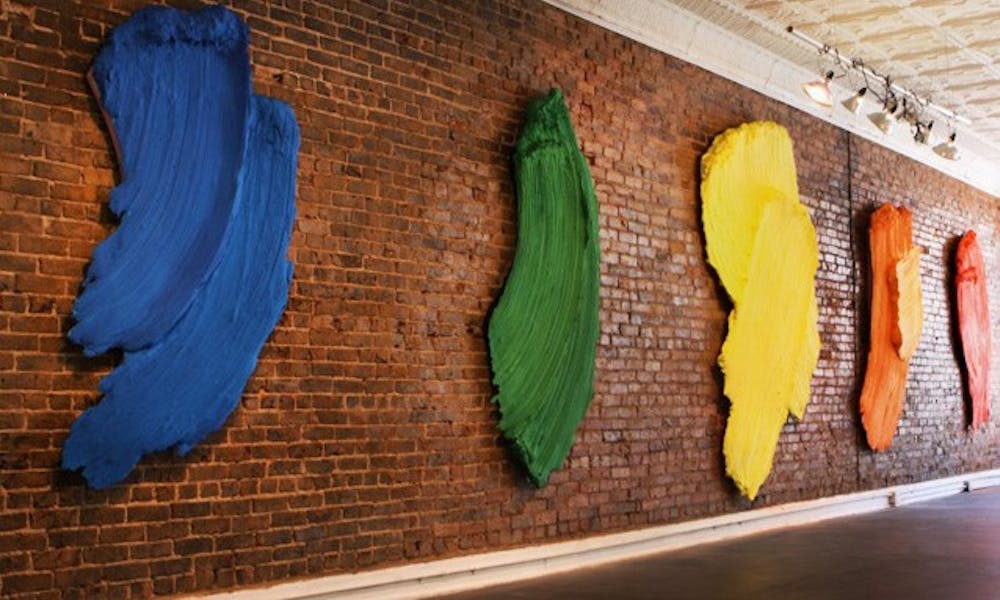The gallery on the second floor of 111 West Parrish Street in downtown Durham carries an odd moniker. But, according to founder and local artist John Wendelbo, there’s something fitting to the name of the new Carrack Modern Art gallery.
“The carrack was a ship used by explorers in the 15th century,” Wendelbo explained. “It was a platform: Trust people, and then see what happens.”
It was with this exact philosophy in mind that Wendelbo started the Carrack Modern Art, a new one-room, brick-walled art gallery devoted to visual art, sculpture, installation, performance, music, poetry and various other artistic mediums.
The gallery, which opened this past July, came to fruition through the preexisting Durham Sculpture Project (DSP), a venture also directed by Wendelbo that uses “large-scale, high-impact” sculpture to foster socio-economic development and artistic engagement in Durham. For Wendelbo, the Carrack grew naturally from the objectives of the DSP.
“Part of the premise of the Durham Sculpture Project is to build a platform for other projects,” Wendelbo said. “[I thought the Carrack] would be a really good implementation of that idea. If we provided a little bit of the infrastructure, we could see if the project can morph into its own existence.”
Infrastructure has been key in the Carrack’s recent development. The gallery operates under a zero-commission model, meaning that 100 percent of the gallery’s art sales flow back to the artists themselves. In this way, Wendelbo said, the Carrack’s goal is to empower artists to focus on their work rather than logistical demands that are often restrictive.
“We put the money back into the artists’ hands so they can have a better shot of making more art,” he said. “By freeing the artist from that [logistical or monetary] predetermination, you…free the art a lot.”
Given the current economic climate and the Carrack’s non-institutional stature, these aims have not been easy to fulfill. The gallery itself runs entirely on donations, mostly through its Kickstarter page, which currently challenges donors to secure the gallery’s rent for the entirety of 2012.
“The urgency of this Kickstarter thing—it’s all or nothing. It’s very good in many ways,” Wendelbo said. “If people make pledges, it’s a done deal and the space will be open entirely for 2012.”
Until the gallery reaches its $12,000 goal, though, it must subsist on the month-to-month donations that have kept the space running so far.
“The fact that we are zero-commission is unheard of in conventional art spaces,” Laura Ritchie, a 2010 UNC-Chapel Hill graduate and gallery director for the Carrack, wrote in an email. “We are willfully taking a huge risk by not having any guarantee of profit. There’s no way of knowing if we’ll be able to open our doors next month.”
The openness and fluidity of the Carrack’s approach extends to the types of exhibitions the gallery decides to undertake. Last Friday, the Carrack hosted the third of the Triangle’s PoPuP Art Shows, a one-night-only exhibition model forwarded by Adrian Schlesinger, an art student at UNC-Chapel Hill, as part of her honors thesis project. Schlesinger’s idea of the PoPuP shows—as jumpstarters of creative dialogue that engage the local community in art and social and economic progress—is closely aligned with the Carrack’s innovative, forward-looking mentality.
“I love the pop-up idea of ‘let’s just go for it,’” Schlesinger said. “The best things in the art world happen when you just go for it.”
Thus far, the Carrack has devoted itself to exhibitions and events that maintain a similar philosophy of spontaneous and collaborative artistic production. Besides the PoPuP show, the gallery has featured solo shows by “visual activist” Franco and Durham-based visual and installation artist Catherine Howard. In the coming months, the gallery plans to continue featuring both local and national artists as an affirmation of the Carrack’s commitment to diversity.
Ultimately, though, the Carrack’s future depends entirely on the Durham community’s reception of the space.
“I’m very attached to the notion of having broad-based support [for the gallery],” Wendelbo said. “[There needs to be] a sense of ownership—a community-based ownership of the gallery.”
Wendelbo stressed that the Carrack, still in its nascent stages, must be widely accepted and supported to remain artistically and socially productive.
“It’s a very large asset to community at large,” he said. “It’s about art sustainability. I’d like to educate, in a sense, the community at large, [to tell them that]… when we empower artists and give them the means to express themselves, the freedom to do stuff, things will happen. You need to trust the process.”
Both Wendelbo and Ritchie hope that the Carrack’s up-in-the-air status will serve as a call to arms for Durham.
“It is a challenge to the community and an experiment. In a way, we’re saying, ‘Hey, Durham, how much do you really want this for your art community?’” Ritchie said. “We are 100% dependent on the response that this is worth their time and money.”
Get The Chronicle straight to your inbox
Signup for our weekly newsletter. Cancel at any time.

